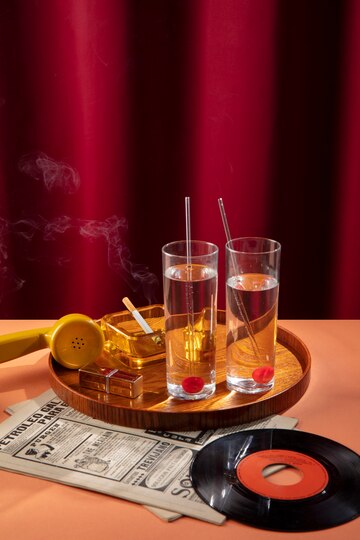FASHION
Bitters for Old Fashioned: Elevating Your Cocktail Game

Few ingredients in the world of mixology have as much influence over a classic cocktail’s taste character as bitters. These little, concentrated drinks have a long history that begins with the early years of the cocktail movement. Today, we take a closer look at bitters and how they helped to create the classic Old Fashioned drink.
What Makes a Great Old Fashioned?
In order to fully comprehend the importance of bitters in an Old Fashioned, one must first be aware of what makes for a superb preparation of this classic cocktail. The right proportions of rye or bourbon whiskey, sugar, water, and, of course, bitters make up an ideal Old Fashioned.
The Role of Bitters in Cocktails
Bitters are the hidden heroes of mixology—they are more than just ingredients. These intense infusions of spices, herbs, and botanicals improve the whole drinking experience by adding richness, depth, and a touch of bitterness.
History of Bitters
It’s necessary to wander through history in order to truly enjoy bitters. Bitters were originally used for medical purposes in antiquity. During the 19th century, they made their way into the cocktail industry and became a crucial component of the bartender’s arsenal.
Types of Bitters
Any well-stocked bar will probably have a wide selection of bitters when you go in. The selection is wide, with anything from traditional aromatic bitters to unusual tastes like chocolate and cherry, each adding a distinct touch to your beverage.
Benefits of Using Bitters
Bitters have several advantages beyond just enhancing tastes. They help with digestion, offer a fragrant burst, and can even improve a cocktail’s overall appearance.
Popular Bitters for Old Fashioned
As far as Old Fashioneds go, not all bitters are made equally. Some are notable for their capacity to balance the strong tastes of whiskey. In the Old Fashioned world, a few brands that have become legendary are Angostura, Peychaud’s, and Fee Brothers.
How to Choose the Right Bitters for Your Old Fashioned
Selecting the ideal bitters for your Old Fashioned is an individual experience. Take into account the flavor characteristics of your whiskey, try out several bitter combinations, and discover the one that most entices your palate.
DIY Bitters: A Fun Experiment
For those who are daring enough, making your own bitters may be a fulfilling endeavor. Collect herbs, spices, and a base alcohol to create a customized concoction that expresses your own tastes.
Bitters and Health Benefits
Bitters are thought to provide health advantages in addition to their use in mixing drinks. The botanical components of bitters have been used for ages due to their possible medical benefits, which range from assisting with digestion to serving as a natural appetite stimulant.
Common Misconceptions About Bitters
Myths surround the usage of bitters, much like any issue. Some people think they’re overwhelming, while others say they’re just for the skilled bartender. Actually, bitters are adaptable and may be made to fit different tastes.
Bitters in Modern Mixology
Bitters are still quite popular in this age of creative cocktails. the Bitters are not a thing of the past; rather, mixologists all over the world use these powerful liqueurs in their current cocktails, demonstrating that bitters are essential to modern mixology.
Interview with a Mixologist
We chatted with an experienced mixologist to get more details, and she offered her knowledge of using bitters in Old Fashioned versions. Both novices and experienced mixologists can benefit greatly from their advice and suggestions.
Customer Reviews and Recommendations
Experience in the real world speaks loudly. We go through reviews and suggestions from customers to find out which bitters are most popular among drinkers. The community’s picks for social media and online forums provide insightful advice for anybody wishing to improve their Old Fashioned experience.
Conclusion
The secret ingredient that gives the Old Fashioned its additional layer of perfection is bitters. This drink is a timeless classic in the world of cocktails. Bitters have always been important, from their historical origins to the tools used by contemporary mixologists. The road is just as thrilling as the outcome, whether you choose to make your own bitters or stick to the classics.
Frequently Asked Questions
-
Are bitters necessary for an Old Fashioned?
- While not mandatory, bitters are a key element that adds complexity and depth to the Old Fashioned. They are highly recommended for an authentic experience.
-
Can I use any bitters in my Old Fashioned?
- Experimentation is encouraged, but some bitters, like Angostura and Peychaud’s, are classic choices known to complement the flavors of an Old Fashioned.
-
What’s the difference between aromatic and flavored bitters?
- Aromatic bitters have a more traditional blend of botanicals, while flavored bitters add additional elements like fruits, spices, or chocolate for a unique twist.
-
How do I store bitters?
- Store bitters in a cool, dark place, away from direct sunlight. This helps maintain their flavor and potency.
-
Can bitters be used in non-alcoholic cocktails?
- Absolutely! Bitters can enhance the flavor of non-alcoholic drinks, providing a sophisticated
FASHION
Art and Fashion Colleges in Uganda: Cultivating Creativity and Style

Art and Fashion Colleges in Uganda: Cultivating Creativity and Style
Art and Fashion Colleges in Uganda fashion and art have always been closely related, influencing one another constantly via creative exchanges. This synthesis is particularly evident in Uganda, where designers and artists are influenced by the rich cultural legacy of the nation.
Why Choose Uganda for Art and Fashion Studies?
Cultural Richness
Uganda’s many cultures offer a distinctive setting for artistic investigation. With so much inspiration available to them, students may draw inspiration from everything from traditional clothing to modern art forms.
Affordable Education
Uganda offers art and fashion education at a substantially lower cost than many Western countries, which attracts foreign students.
Emerging Market
Emerging designers and artists have a bright future in Uganda because to the country’s expanding economy and increased demand for locally produced goods.
Top Art and Fashion Colleges in Uganda
Kampala School of Design (KSD)
Uganda’s growing economy and rising demand for locally made items bode well for the country’s up-and-coming designers and artists. KSD, which is centrally located in Kampala, provides a variety of fine arts, graphic design, and fashion design programs. The institution is renowned for its links to business and pragmatic approach to teaching.
Margaret Trowell School of Industrial and Fine Arts
Margaret Trowell School is one of Uganda’s oldest and most prestigious art schools, and it is a component of Makerere University. Numerous courses in visual arts, sculpting, and textile design are available.
Uganda Christian University (UCU)
UCU’s Department of Art and Design is committed to nurturing creativity and innovation. With modern facilities and experienced faculty, it’s a hub for aspiring artists and designers.
Mengo Senior School
Mengo Senior School features a robust arts department that enables pupils to experiment with many materials and styles, despite not being a designated art school.
Makerere University School of Fine Art
Makerere University School of Fine Art is an esteemed establishment that has a rich legacy of producing exceptional artists. It provides degree programs in painting, sculpture, and art teaching.
Kyambogo University
The art and design department at Kyambogo University equips students for jobs in both classic and modern art genres by emphasizing practical skills and hands-on experience.
Courses Offered
- Fashion Design: From sketching to garment construction, students learn the ins and outs of creating wearable art.
- Fine Arts: Painting, sculpture, and mixed media techniques are explored, allowing students to develop their artistic voice.
- Textile Design: This course delves into the world of fabrics, patterns, and printing techniques.
- Graphic Design: Combining art and technology, graphic design students learn to communicate visually through digital mediums.
Facilities and Resources
Ugandan art and fashion schools are equipped with state-of-the-art facilities to encourage students’ artistic pursuits. Modern studios, well furnished workshops, and sizable libraries offer a supportive study environment.
Student Life
Students can engage in a variety of groups and organizations devoted to art and fashion outside of the classroom. These extracurricular activities provide an opportunity to network and display one’s abilities.
Career Prospects
Graduates from fashion and art schools in Uganda work in an industry that is both lucrative and competitive. The opportunities are endless, ranging from starting their own fashion labels to serving as art directors for well-known companies.
Challenges and Opportunities
Although Uganda’s creative sector is flourishing, there are still obstacles to overcome, such a lack of finance and market accessibility. Nonetheless, these obstacles also offer chances for creativity and business ventures.
Inspirational Success Stories
Successful alumni’s biographies inspire present students. These tales, which range from well-known artists to up-and-coming fashion designers, demonstrate the value of art and fashion education in Uganda.
Future of Art and Fashion in Uganda
The future of fashion and the arts appears bright as long as the nation supports its creative sectors. Uganda is ready to leave its mark on the international creative scene because to institutional backing, government efforts, and a rising awareness for regional talent.
Conclusion
In Uganda, art and fashion universities are essential for developing talent, encouraging innovation, and influencing the industry’s future. For those who want to pursue careers in art and design, these universities provide a comprehensive curriculum together with an active student body.
Frequently Asked Questions (FAQs)
-
Are scholarships available for international students?
- Some institutions offer scholarships based on merit or need. It’s best to check with the specific college for details.
-
Can I study both fashion design and fine arts?
- Yes, many colleges allow students to explore multiple disciplines to broaden their skills.
-
What career paths can I pursue after graduation?
- Graduates can work as fashion designers, art directors, illustrators, textile artists, and more.
-
Is there a market for locally-made fashion in Uganda?
- Yes, with the growing interest in African fashion, there is a thriving market for unique, locally-made designs.
-
How can I apply to these colleges?
- Each college has its own application process. Visit their websites or contact admissions offices for detailed information.
FASHION
Art and Fashion Colleges in Uganda

Art and Fashion Colleges in Uganda fashion and art have long been important social constructs that represent personal expression and cultural identity. There has been a noticeable increase in demand for creative education in Uganda in recent years. With the country’s embracing of its rich creative legacy and recognition of the fashion industry’s potential, the construction of art and fashion institutions has become essential to developing talent and encouraging creativity.
Overview of the Education System in Uganda
Prior to digging into the details of art and fashion institutions, it is important to comprehend the educational system in Uganda. Uganda adheres to a system of basic, secondary, and post-secondary education, similar to many other nations. Universities, colleges, and vocational training facilities are all part of tertiary education.
Rise of Art and Fashion Colleges in Uganda
The establishment of fashion and art institutions in Uganda marks a paradigm change in the understanding of the role of the creative industries. This tendency not only meets the increasing need for qualified workers but also makes a major economic contribution to the nation.
Top Art and Fashion Colleges in Uganda
A number of establishments are notable for their dedication to provide top-notch instruction in the domains of art and fashion. The Margaret Trowell School of Industrial and Fine Arts, Uganda Technical College-Lira, and Makerere University School of Industrial and Fine Arts are a few of the best universities.
Courses Offered
These universities provide a broad selection of courses designed to fulfill students’ varied interests and professional goals. Among the many programs offered are those in fashion, textile, graphic, fine arts, and interior design.
Faculty and Facilities
These universities, which are well-known for their cutting-edge facilities and knowledgeable teachers, guarantee that students receive thorough instruction and exposure to industry standards.
Admission Process
A thorough selection procedure is conducted for potential students, which may involve portfolio evaluations, interviews, and verification of academic credentials. Every institution has unique admissions policies and procedures.
Career Opportunities
There are several job options open to Ugandan graduates of art and design institutes. Among other things, they can become fashion designers, painters, illustrators, stylists, and teachers.
Challenges Faced
Even with the advancements, Uganda’s art and fashion schools continue to confront obstacles including poor facilities, low financing, and a lack of understanding of the value of creative education.
Success Stories
Numerous former students of these universities have had a major impact on Uganda’s fashion and art scenes on a national and worldwide level. Both present and future students can draw inspiration from their success stories.
Impact on Ugandan Society
Beyond aesthetics, art and fashion have a significant impact on Ugandan culture, helping to shape cultural identity, encourage social change, and promote innovation.
Future Prospects
Uganda’s art and fashion education industry has enormous growth and development potential with sustained support and investment. In the upcoming years, the sector should see even more advancements.
Testimonials
“My time as a student at an art and fashion college in Uganda has been life-changing. My education and abilities have prepared me for a lucrative job in the creative sector.” – Sarah K., student of fashion design
“My college’s instructors are enthusiastic about fostering talent and helping students reach their greatest potential. I appreciate all of the guidance and assistance I’ve had along the way. David M., a student of fine arts
Conclusion
In Uganda, art and fashion institutions are essential for developing talent, encouraging creativity, and advancing the country’s economy. These institutions are influencing the direction Uganda’s creative industries will take by offering high-quality education and encouraging a creative culture.
FAQs
-
Are art and fashion colleges in Uganda accredited?
- Yes, most colleges are accredited by the relevant authorities in Uganda.
-
What career opportunities are available to graduates?
- Graduates can pursue careers in fashion design, graphic design, fine arts, textile design, and more.
-
How long do programs typically last?
- Program durations vary, but most undergraduate programs last between three to four years.
-
Are scholarships available for students?
- Some colleges offer scholarships and financial aid to deserving students.
-
What sets Ugandan art and fashion colleges apart from others?
- Ugandan colleges offer a unique blend of traditional craftsmanship and contemporary design, reflecting the country’s rich cultural heritage.
FASHION
Ethereal Flames: The Enchanting World of Radiant Cut Diamond Rings

Radiant cut diamonds, with their mesmerizing brilliance and unique faceting, stand as true testaments to the artistry and craftsmanship within the realm of fine jewelry. In this exploration, we delve into the ethereal flames that ignite from the facets of radiant cut diamond rings, transcending them beyond mere adornments into captivating symbols of everlasting love and elegance.
The Unparalleled Brilliance of Radiant Cuts
Radiant cut diamonds are renowned for their exceptional brilliance, a result of their distinctive faceting style. These diamonds blend the elegance of step-cut designs with the fiery brilliance of brilliant-cut diamonds. The result? A scintillating play of light that dances through the facets, casting a radiant glow that captures hearts and mesmerizes onlookers.
Craftsmanship Unveiled: Mastering the Art of Radiant Cuts
Crafting a radiant cut diamond requires the expertise of skilled artisans who meticulously shape and polish each facet to perfection. The precision in cutting is paramount, ensuring that the diamond achieves optimal symmetry and alignment, unleashing its full potential for brilliance. It is in the hands of these artisans that the ethereal flames of radiant cut diamonds are forged.
Unraveling the Allure: Why Choose Radiant Cut Diamond Rings
Timeless Elegance Meets Contemporary Flair
Radiant Cut Engagement Rings strike the perfect balance between timeless elegance and contemporary flair. The square or rectangular shape, coupled with trimmed corners, lends a modern touch, making them ideal for those seeking a harmonious blend of classic and contemporary styles. It’s a choice that transcends fleeting trends, ensuring a timeless allure that withstands the test of time.
Versatility Redefined: From Engagement to Everyday Glamour
The versatility of radiant cut diamond rings knows no bounds. While these diamonds make a stunning statement in engagement rings, their adaptability extends to various jewelry styles. Whether adorning a pendant, earrings, or a luxurious bracelet, the ethereal flames of radiant cuts add a touch of sophistication to any ensemble, elevating everyday glamour to extraordinary heights.
Choosing Radiant Cut Diamond Rings: A Buyer’s Guide
When venturing into the world of radiant cut diamond rings, understanding the 4 Cs is crucial. Clarity reveals the purity of the diamond, Cut determines its brilliance, Color enhances its aesthetic, and Carat Weight speaks to its size. Together, these factors harmonize to create a radiant cut diamond that embodies perfection, reflecting the ethereal flames that define its allure.
Setting the Stage: Choosing the Perfect Setting
The setting of a radiant cut diamond plays a pivotal role in enhancing its beauty. Opting for a prong setting allows maximum light exposure, amplifying the ethereal flames. Alternatively, a halo setting can add an extra layer of brilliance, framing the radiant cut with smaller diamonds for an enchanting effect. The choice of setting is a personalized touch that accentuates the unique qualities of each radiant cut diamond.
Ethereal Flames in the Spotlight: Celebrities and Radiant Cut Diamond Rings
Red Carpet Glamour: A-Listers and Radiant Cuts
Celebrities have long been drawn to the allure of radiant cut diamond rings. From Hollywood’s red carpets to glamorous events, A-listers showcase the timeless elegance and modern sophistication of these diamonds. Their choice further propels the radiant cut into the limelight, solidifying its status as a symbol of luxury and style.
Conclusion
the world of radiant cut diamond rings is a captivating journey into the heart of brilliance and sophistication. From the craftsmanship that shapes these diamonds to the versatile elegance they exude, radiant cuts stand as a beacon of enduring love and refined taste. Choosing a radiant cut diamond is not just a purchase; it’s an investment in timeless beauty that transcends generations.


